Numerical Study on the Enhanced Oil Recovery by CO2 Huff-n-Puff in Shale Volatile Oil Formations
Abstract
1. Introduction
2. Methodology
2.1. Molecular Diffusion
2.2. Gas Adsorption
2.3. Nanopore Confinement
2.4. Strss-Sensitive Effect
3. Numerical Simulation Model
3.1. Phase Behavior Model
3.2. Reservoir Model
4. Results and Discussion
4.1. Advantages of CO2
4.2. Effect of CO2 Injection Rate
4.3. Effect of Soaking Time
4.4. Effect of the Number of CO2 Huff-n-Puff Cycles
5. Conclusions
- The utilization of CO2 in huff-n-puff operations demonstrates significant potential for enhancing oil recovery in shale reservoirs. The simulation results underscore the superiority of CO2 over other gases in improving both the recovery rate and the overall efficiency of the process.
- A critical factor influencing the effectiveness of CO2 huff-n-puff is the injection rate. The study identifies an optimal injection rate of 400 tons/day, beyond which the benefits of increased injection rates diminish and can lead to suboptimal gas utilization.
- The duration of the soaking period is another pivotal parameter, with the study suggesting that a soaking time of 30 days is most effective. This period allows for adequate contact between the injected CO2 and the reservoir fluids, facilitating better oil displacement.
- The research reveals that three cycles of CO2 huff-n-puff are optimal for maximizing oil recovery. Beyond this point, the incremental benefits of additional cycles decrease, and the process becomes less efficient.
Author Contributions
Funding
Data Availability Statement
Conflicts of Interest
References
- Ma, Y.S.; Cai, X.Y.; Zhao, P.R.; Hu, Z.; Liu, H.; Gao, B.; Zhang, Z. Geological characteristics and exploration practices of continental shale oil in China. Acta Geol. Sin. 2022, 96, 155–171. [Google Scholar]
- Jin, Z.J.; Bai, Z.R.; Gao, B.; Li, M. Has China ushered in the shale oil and gas revolution ? Oil Gas Geol. 2019, 40, 451–458. [Google Scholar]
- Du Jinhu, H.S.; Zhenglian, P.; Senhu, L.; Lianhua, H.; Rukai, Z. The types, potentials and prospects of continental shale oil in China. China Pet. Explor. 2019, 24, 560. [Google Scholar]
- Zou, C.; Pan, S.; Zhao, Q. On the connotation, challenge and significance of China’s “energy independence” strategy. Pet. Explor. Dev. 2020, 47, 449–462. [Google Scholar] [CrossRef]
- Zhao, W.; Hu, X.; Hou, L. Development potential and technical strategy of continental shale oil in China. Pet. Explor. Dev. 2020, 47, 819–828. [Google Scholar]
- Wang, P.; Liu, Z.; Zhang, D.; Li, X.; Liu, H.; Du, W.; Zhou, L.; Li, Q. Shale oil enrichment conditions and exploration potential of Middle Jurassic Lianggaoshan Formation in Fuxing area, Sichuan Basin. Nat. Gas Geosci. 2023, 34, 1237–1246. [Google Scholar]
- Hamdi, H.; Clarkson, C.R.; Ghanizadeh, A.; Ghaderi, S.M.; Vahedian, A.; Riazi, N.; Esmail, A. Huff-n-Puff gas injection performance in shale reservoirs: A case study from Duvernay Shale in Alberta, Canada. In Proceedings of the Unconventional Resources Technology Conference, Houston, TX, USA, 23–25 July 2018. [Google Scholar]
- Yu, W.; Lashgari, H.; Sepehrnoori, K. Simulation Study of CO2 Huff-n-Puff Process in Bakken Tight Oil Reservoirs. In Proceedings of the SPE Western North American and Rocky Mountain Joint Meeting, Denver, CO, USA, 15–18 April 2014. [Google Scholar]
- Kolawole, O.; Gamadi, T.D.; Bullard, D. Artificial lift system applications in tight formations: The state of knowledge. SPE Prod. Oper. 2020, 35, 422–434. [Google Scholar]
- Sheng, J.J.; Chen, K. Evaluation of the EOR potential of gas and water injection in shale oil reservoirs. J. Unconv. Oil Gas Resour. 2014, 5, 1–9. [Google Scholar] [CrossRef]
- Li, L.; Su, Y.; Sheng, J.J.; Hao, Y.; Wang, W.; Lv, Y.; Zhao, Q.; Wang, H. Experimental and numerical study on CO2 sweep volume during CO2 Huff-n-Puff enhanced oil recovery process in shale oil reservoirs. Energy Fuels 2019, 33, 4017–4032. [Google Scholar] [CrossRef]
- Wang, T.; Yu, Y.; Sheng, J.J. Experimental and numerical study of the EOR potential in liquid-rich shales by cyclic gas injection. J. Unconv. Oil Gas Resour. 2015, 12, 56–67. [Google Scholar]
- Wang, Y.; Tang, Y.; Li, S.; Liu, X. Cyclic gas injection huff-n-puff in multi-stage fracturing horizontal wells to improve recovery of shale oil and gas reservoirs: Taking Eagle Ford Shale in North America as an example. Nat. Gas Ind. 2023, 43, 153–161. [Google Scholar]
- Fu, J.; Yao, B.; Lei, Z.; Tian, Y.; Wu, Y. Enhanced Oil Recovery of Ultra-low Permeability Tight Reservoirs in North America. J. Southwest Pet. Univ. (Sci. Technol. Ed.) 2021, 43, 166–183. [Google Scholar]
- Hoffman, B.T. Comparison of Various Gases for Enhanced Recovery from Shale Oil Reservoirs. In Proceedings of the SPE Improved Oil Recovery Symposium, Tulsa, OK, USA, 14–18 April 2012. [Google Scholar]
- Li, L.; Sheng, J.J.; Xu, J. Gas selection for huff-n-puff EOR in shale oil reservoirs based upon experimental and numerical study. In Proceedings of the SPE Unconventional Resources Conference, Calgary, AB, Canada, 15–16 February 2017. [Google Scholar]
- Zhang, Y.; Sheng, J.; Li, Q.; Song, P.; Yukun, C.; Qin, J. Advances in the Application of CO2 Stimulation Technology. Spec. Oil Gas Reserv. 2021, 28, 1. [Google Scholar]
- Yan, J. Carbon Capture and Storage (CCS). Appl. Energy 2015, 148, A1–A6. [Google Scholar] [CrossRef]
- Aminu, M.D.; Nabavi, S.A.; Rochelle, C.A.; Manovic, V. A review of developments in carbon dioxide storage. Appl. Energy 2017, 208, 1389–1419. [Google Scholar] [CrossRef]
- Kong, X.; Wang, H.; Yu, W.; Wang, P.; Miao, J.; Fiallos-Torres, M. Compositional simulation of geological and engineering controls on gas huff-n-puff in Duvernay shale volatile oil reservoirs, Canada. Energies 2021, 14, 2070. [Google Scholar] [CrossRef]
- Kong, X.; Wang, H.; Yu, W.; Wang, P.; Liu, L.; Zhang, W. Phase Behavior in Nanopores and Its Indication for Cyclic Gas Injection in a Volatile Oil Reservoir from Duvernay Shale. Lithosphere 2022, 12, 5261253. [Google Scholar] [CrossRef]
- Wan, T.; Sheng, J.J. Compositional modeling of the diffusion effect on EOR process in fractured shale-oil reservoirs by gas flooding. J. Cdn Pet. Technol. 2015, 54, 107–115. [Google Scholar] [CrossRef]
- Yu, W.; Lashgari, H.R.; Sepehrnoori, K.; Zhang, T.; Wu, K.; Miao, J. Compositional simulation of CO2 Huff-n-Puff in Eagle Ford tight oil reservoirs with CO2 molecular diffusion, nanopore confinement, and complex natural fractures. In Proceedings of the SPE Improved Oil Recovery Conference, Tulsa, OK, USA, 14–18 April 2018. [Google Scholar]
- Fakher, S.; Imqam, A. Application of carbon dioxide injection in shale oil reservoirs for increasing oil recovery and carbon dioxide storage. Fuel 2020, 265, 116944. [Google Scholar] [CrossRef]
- Lashgari, H.R.; Sun, A.; Zhang, T.; Pope, G.A.; Lake, L.W. Evaluation of carbon dioxide storage and miscible gas EOR in shale oil reservoirs. Fuel 2019, 241, 1223–1235. [Google Scholar] [CrossRef]
- Liu, L.; Yao, J.; Sun, H.; Huang, Z.; Yan, X.; Li, L. Compositional modeling of shale condensate gas flow with multiple transport mechanisms. J. Pet. Sci. Eng. 2019, 172, 1186–1201. [Google Scholar]
- Zarragoicoechea, G.J.; Kuz, V.A. Critical Shift of a Confined Fluid in a Nanopore. Fluid Phase Equilibria 2004, 220, 7–9. [Google Scholar] [CrossRef]
- Chhatre, S.S.; Sinha, S.; Braun, E.M.; Esch, W.L.; Determan, M.D.; Passey, Q.R.; Kudva, R.A. Effect of Stress, Creep, and Fluid Type on Steady State Permeability Measurements in Tight Liquid Unconventional Reservoirs. In Proceedings of the Unconventional Resources Technology Conference, Denver, CO, USA, 25–27 August 2014. [Google Scholar]
- Reyes, L.; Osisanya, S.O. Empirical Correlation of Effective Stress Dependent Shale Rock Properties. J. Can. Pet. Technol. 2002, 41, 90–99. [Google Scholar] [CrossRef]
- Lu, Z.; Wan, Y.; Xu, L.; Fang, D.; Wu, H.; Zhong, J. Nanofluidic Study of Multiscale Phase Transitions and Wax Precipitation in Shale Oil Reservoirs. Energies 2024, 17, 2415. [Google Scholar] [CrossRef]
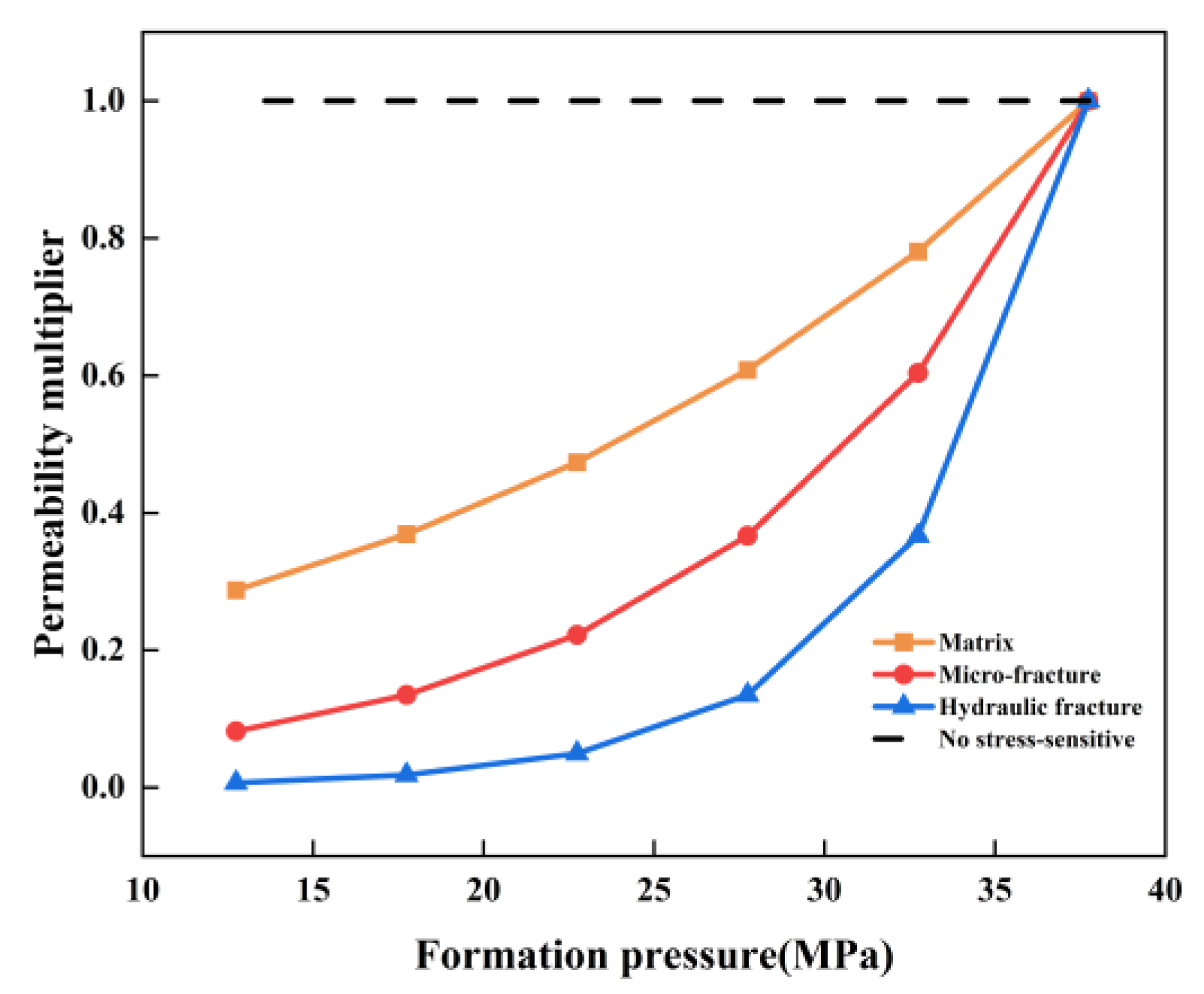
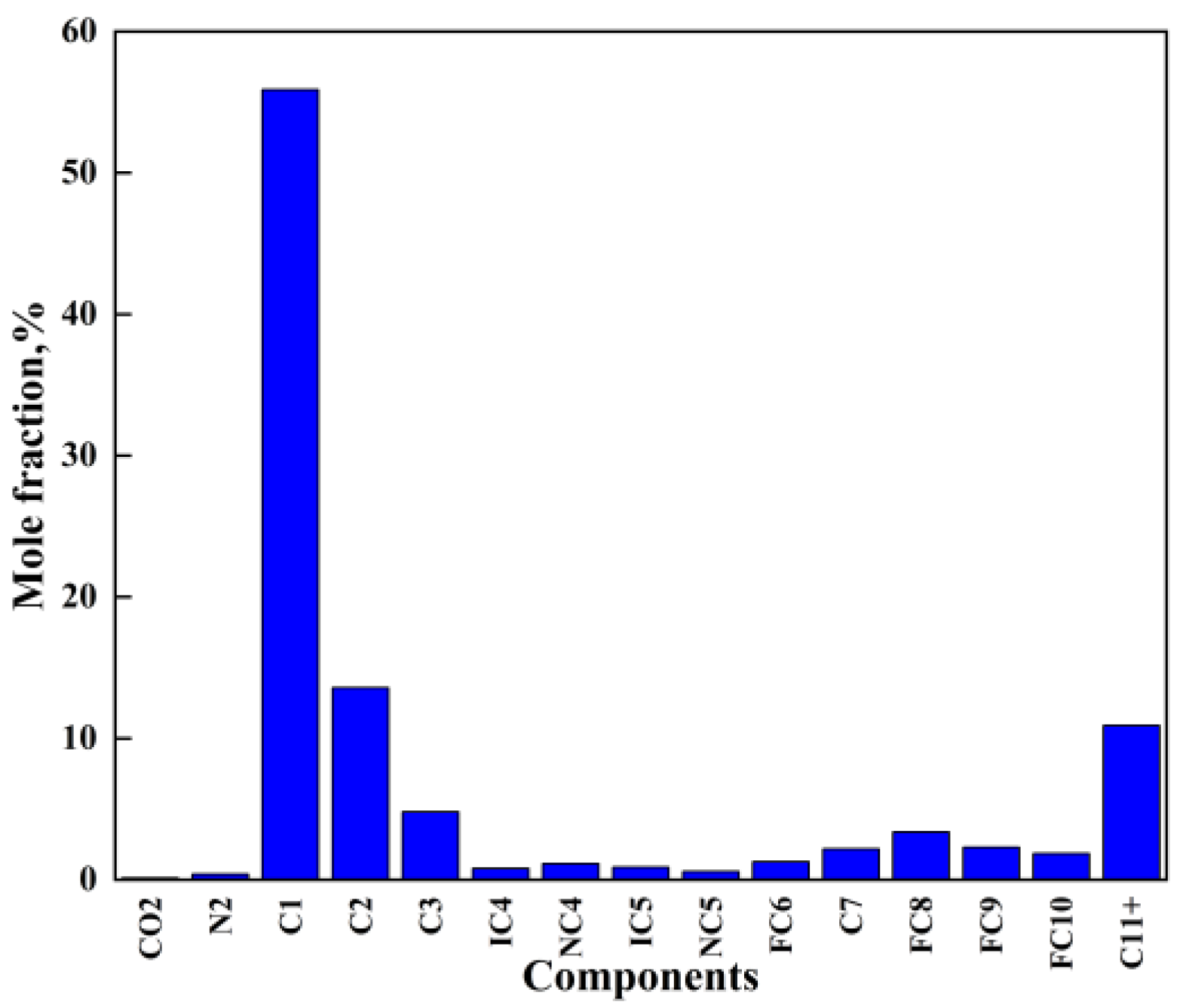
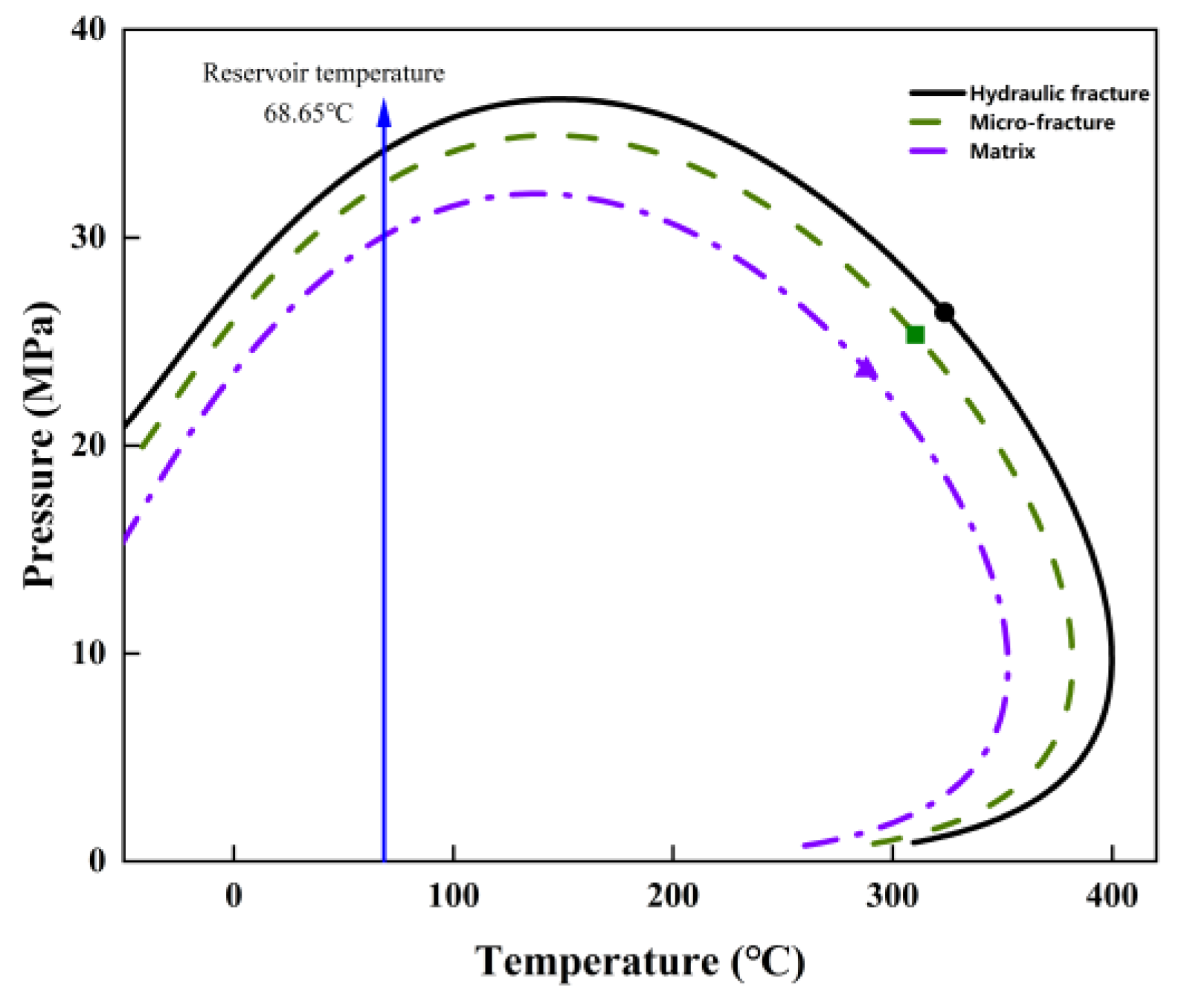

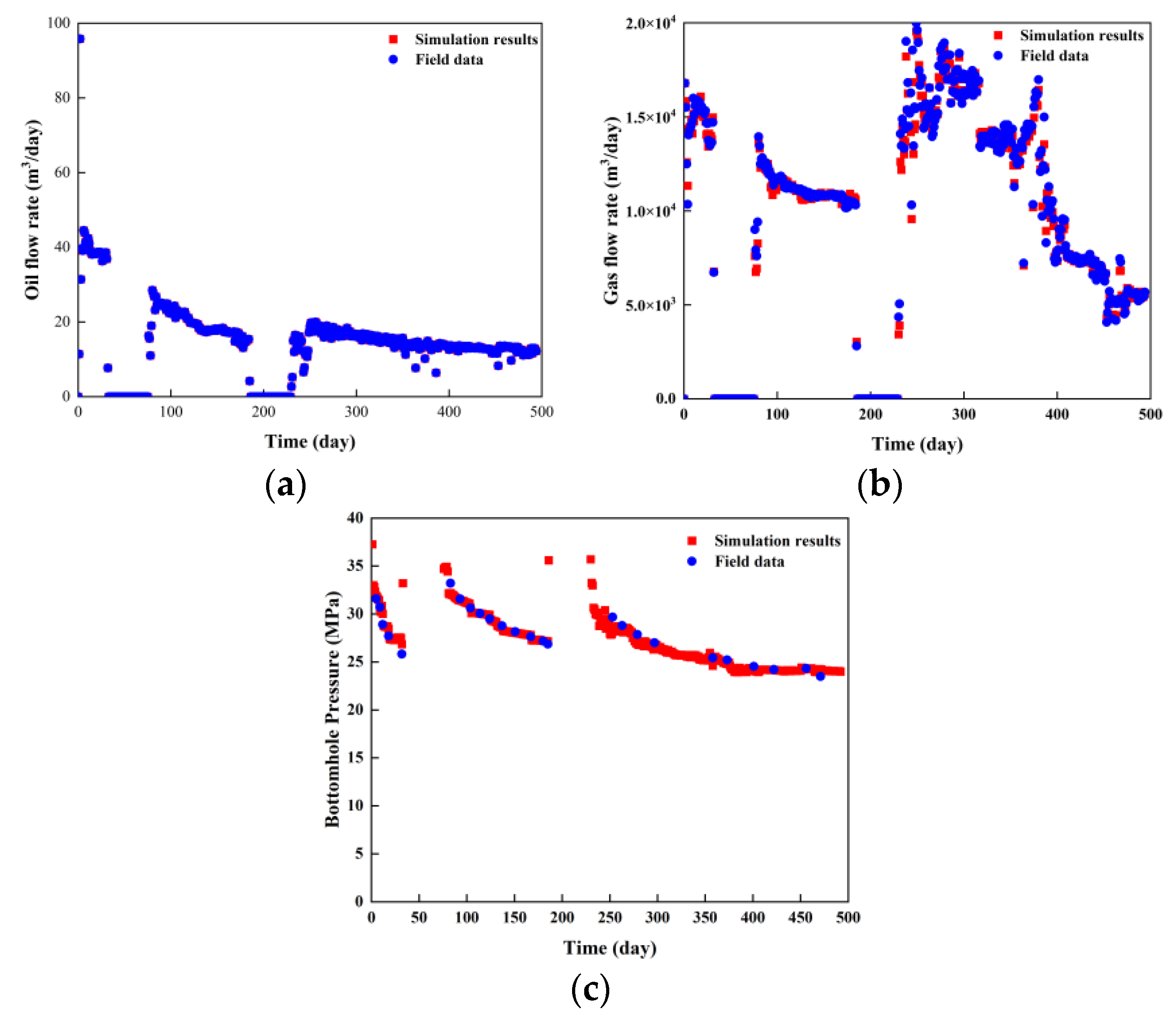
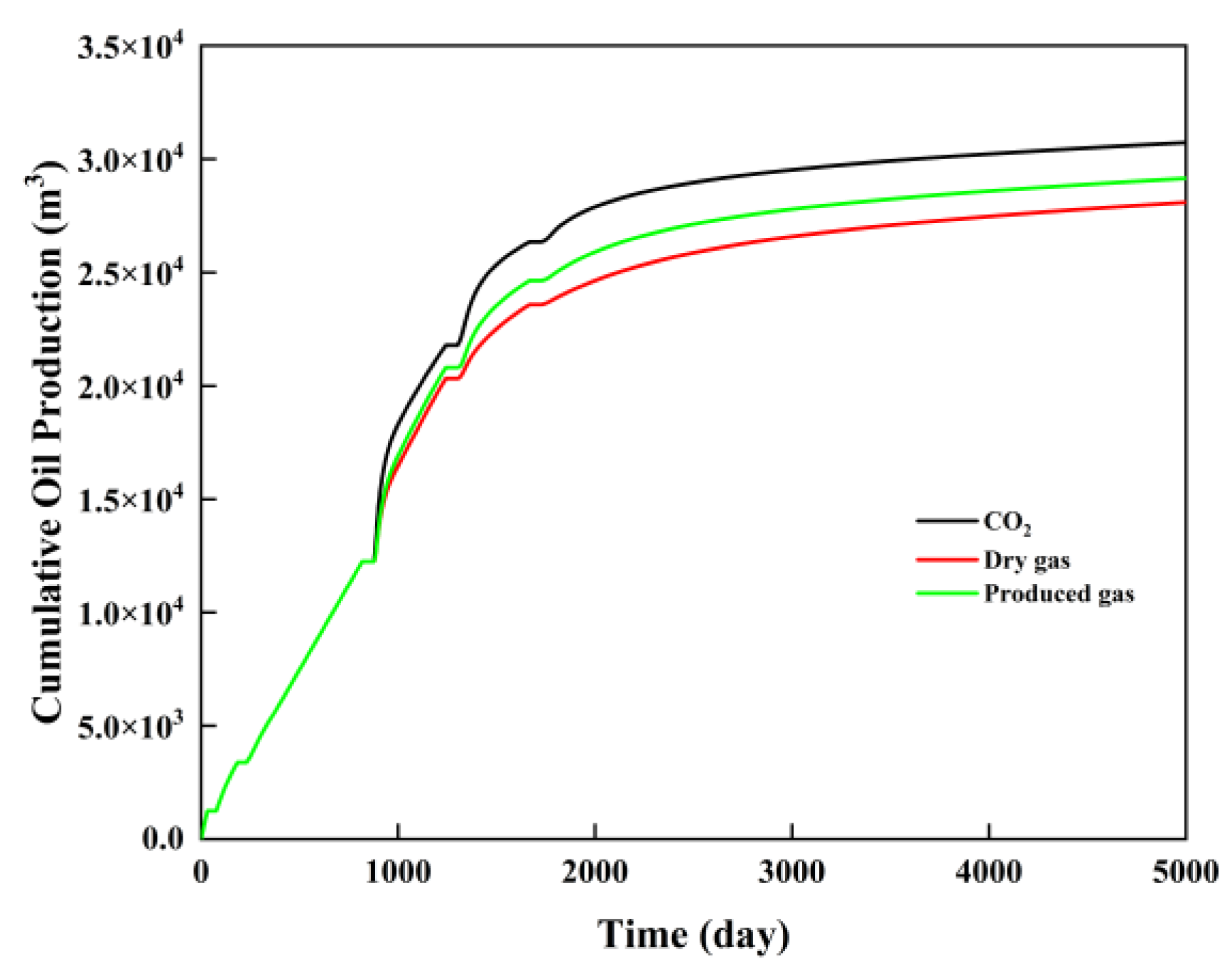


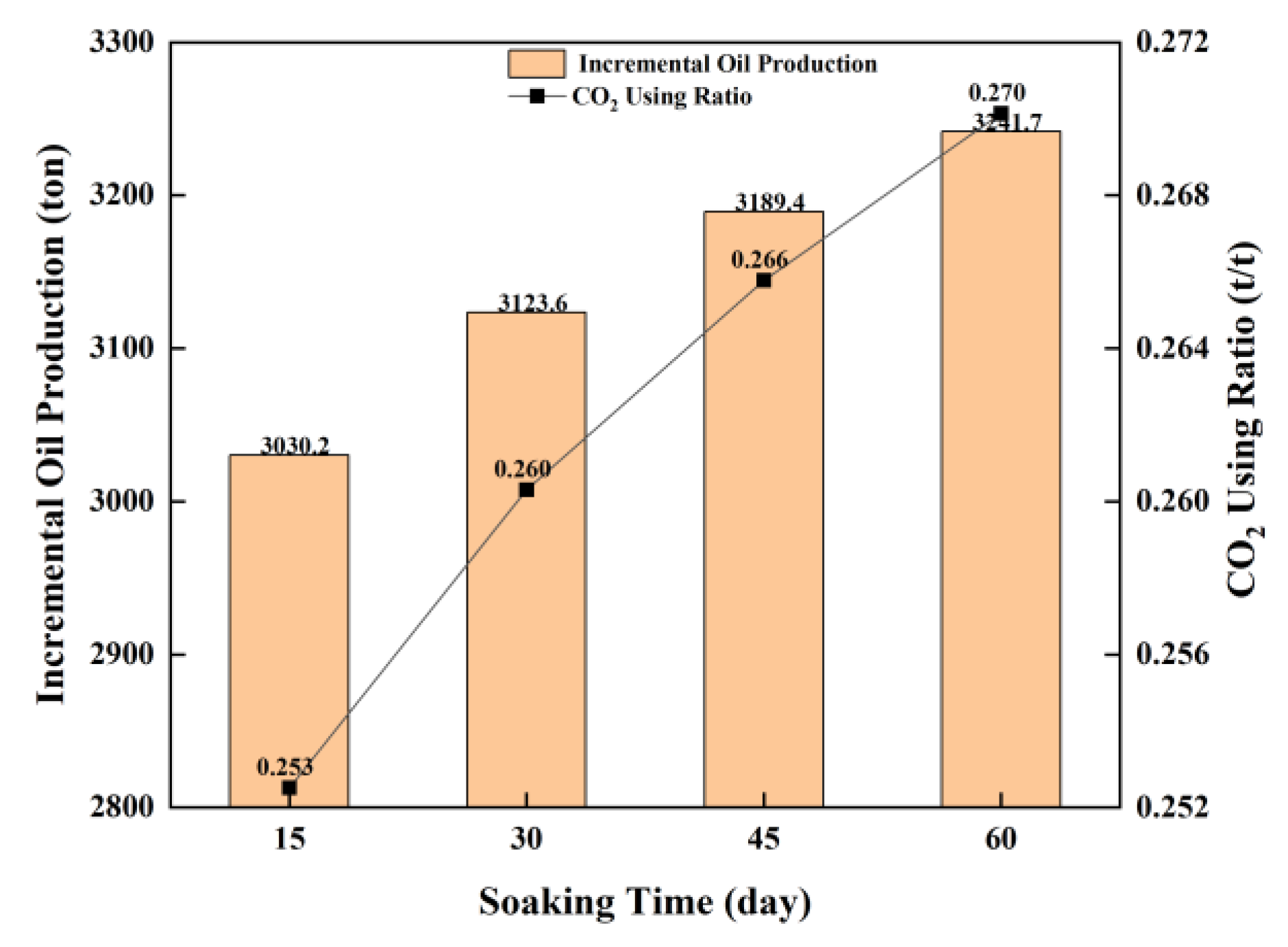
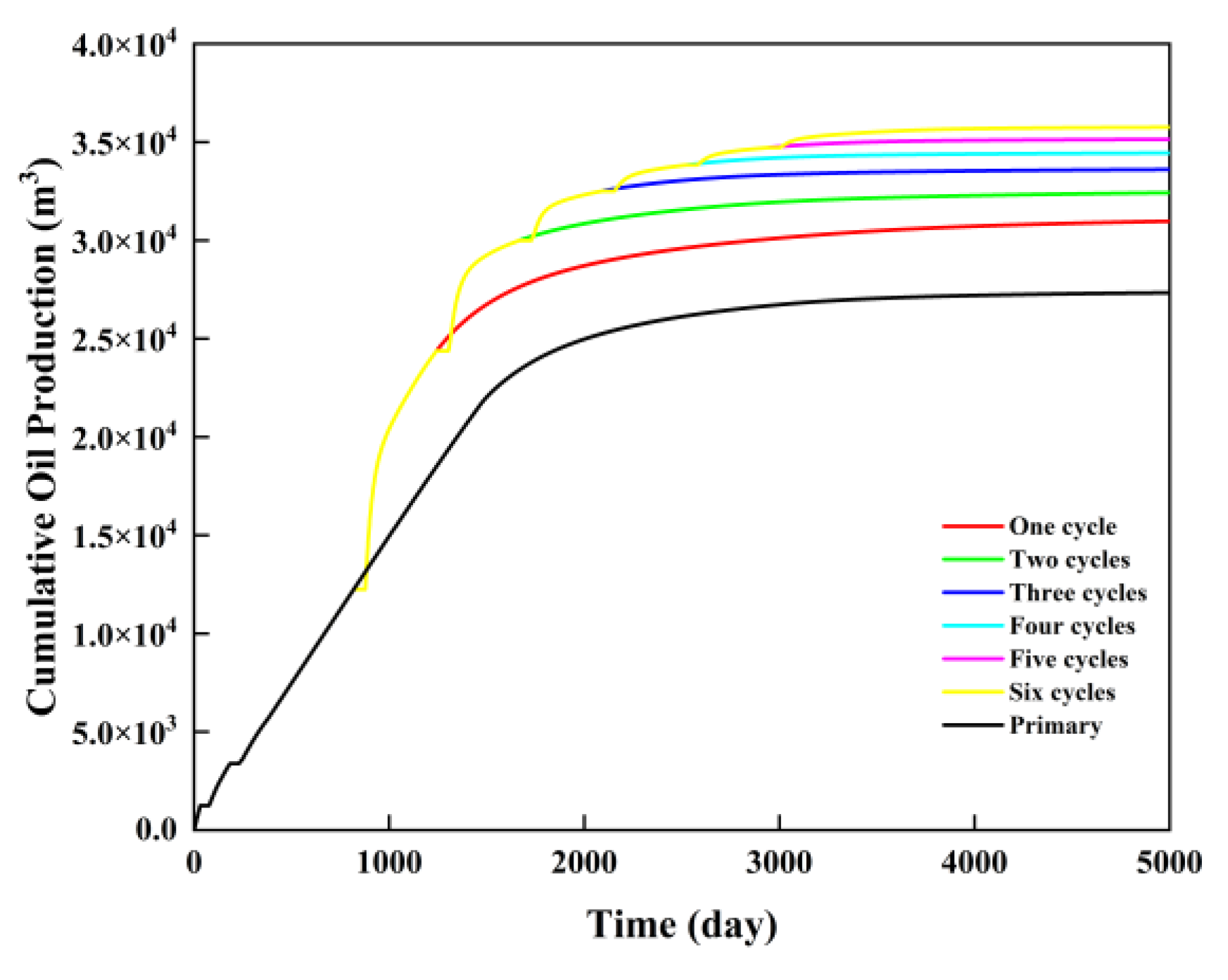
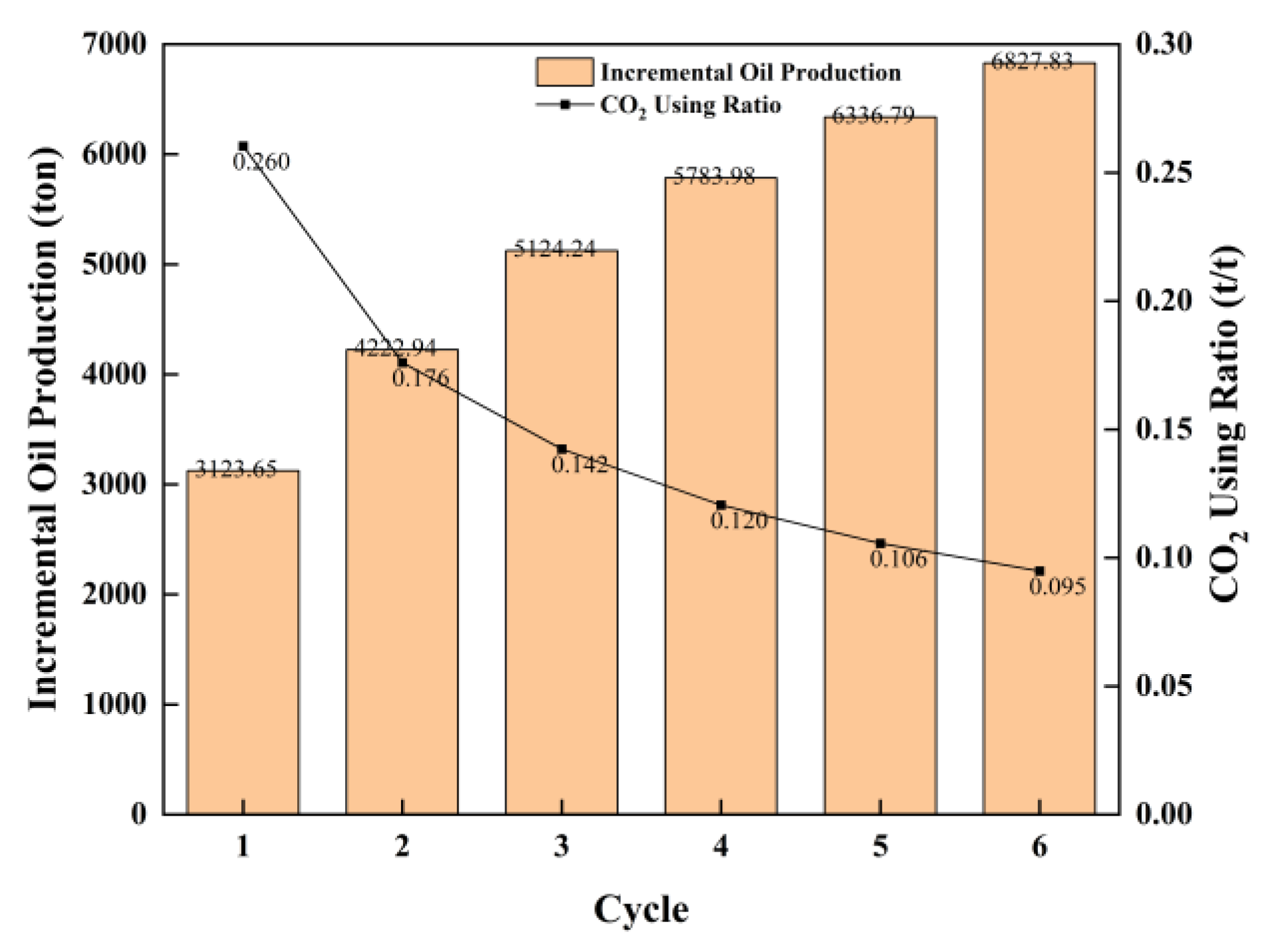
| Pseudo-Components | Mole Fraction (%) |
|---|---|
| CO2 | 0.1147 |
| N2-C1 | 56.2695 |
| C2-NC4 | 20.2952 |
| IC5-C7 | 4.8992 |
| FC8-FC10 | 7.5140 |
| C11+ | 10.9073 |
| Parameter | Value | Unit |
|---|---|---|
| Reservoir dimension | 3900 × 6000 × 30 | m × m × m |
| Number of blocks | 195 × 300 × 5 | - |
| Reservoir temperature | 68.65 | °C |
| Average matrix porosity | 0.0352 | - |
| Average matrix permeability | 0.003 | mD |
| Fracture conductivity | 20 | mD-m |
| Fracture half-length | 125 | m |
| Fracture spacing | 30 | m |
| Component | CO2 | CH4 |
|---|---|---|
| Volume constant (gmole/lb) | 0.083 | 0.033 |
| Pressure constant (1/psi) | 1.22 × 10−3 | 1.26 × 10−4 |
| Injected Gas | MMP |
|---|---|
| CO2 | 15.2 |
| Produced gas | 34.1 |
| Dry gas | 40.3 |
Disclaimer/Publisher’s Note: The statements, opinions and data contained in all publications are solely those of the individual author(s) and contributor(s) and not of MDPI and/or the editor(s). MDPI and/or the editor(s) disclaim responsibility for any injury to people or property resulting from any ideas, methods, instructions or products referred to in the content. |
© 2024 by the authors. Licensee MDPI, Basel, Switzerland. This article is an open access article distributed under the terms and conditions of the Creative Commons Attribution (CC BY) license (https://creativecommons.org/licenses/by/4.0/).
Share and Cite
Zheng, A.; Lu, W.; Zhang, R.; Sun, H. Numerical Study on the Enhanced Oil Recovery by CO2 Huff-n-Puff in Shale Volatile Oil Formations. Energies 2024, 17, 4881. https://doi.org/10.3390/en17194881
Zheng A, Lu W, Zhang R, Sun H. Numerical Study on the Enhanced Oil Recovery by CO2 Huff-n-Puff in Shale Volatile Oil Formations. Energies. 2024; 17(19):4881. https://doi.org/10.3390/en17194881
Chicago/Turabian StyleZheng, Aiwei, Wentao Lu, Rupeng Zhang, and Hai Sun. 2024. "Numerical Study on the Enhanced Oil Recovery by CO2 Huff-n-Puff in Shale Volatile Oil Formations" Energies 17, no. 19: 4881. https://doi.org/10.3390/en17194881
APA StyleZheng, A., Lu, W., Zhang, R., & Sun, H. (2024). Numerical Study on the Enhanced Oil Recovery by CO2 Huff-n-Puff in Shale Volatile Oil Formations. Energies, 17(19), 4881. https://doi.org/10.3390/en17194881






